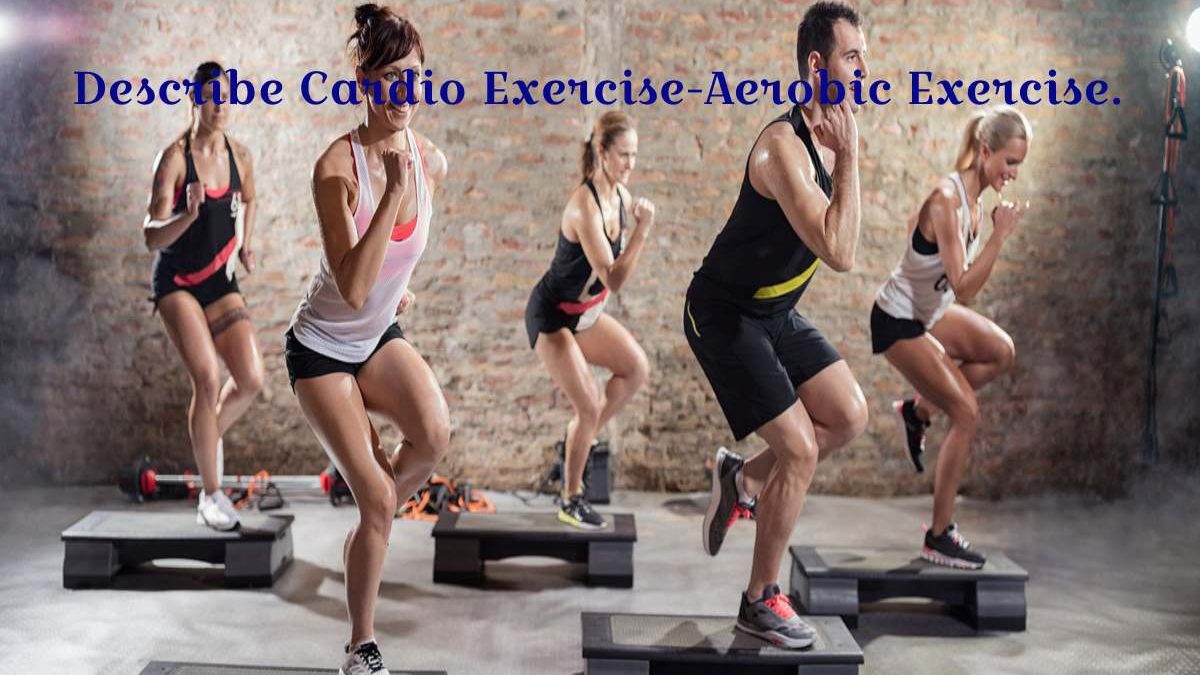Any rhythmic exercise that pushes your heart rate into your desired heart rate zone is known as cardio exercise, also known as aerobic exercise. You burn the maximum calories and fat in this area.
Exercise that raises your heart rate is referred to as cardiovascular exercise. Cardio Exercise provides additional advantages besides weight reduction, even though some individuals utilise it. There are many different cardiovascular workouts, but consistency, length, and intensity are crucial for achieving your fitness objectives. Please continue reading to learn more about this exercise form, its advantages, and how to design a secure and efficient cardiovascular programme.
Any exercise involving aerobic metabolism is called Cardio Exercise, often known as aerobic or endurance exercise. Oxygen plays a significant role in the cellular processes that result in the energy required to maintain the activity throughout the activity. Your heart rate rises, and you breathe more deeply. As a result, you have more power and do not get fatigued quickly.
Which Cardio Exercises Are Performed Most Frequently?
Swiftly moving, Running, running continuously or jogging, Burpees, A bear creeps, Swimming, Water exercise, Cycling/bicycling, Dancing, skiing in the distance, Race-walking Tennis, racquetball, basketball, or volleyball, Rowing paddleboarding, canoeing, or kayaking Exercise circuits bouncing rope ascending stairs Skating in place fights arts Golfing Hiking HIIT (High-Intensity Interval Training) climbing mountains, jumping jacks, lunges, and splits Inline skating Kickboxing.
The Cardiac Equipment That Is Most Often Utilised Is as Follows:

- Treadmill
- A Stair Machine
- Cycle Stationery
- Trained Skier
- The Rowing Machine
- Elliptical Exerciser
- Rear-Wheel Bike
- Standing Bicycle
- Climber Of Stairs
- An Upper Body Ergometer
- Wave-Trainer
- Versa-Climber
- AMT Precor
Which Of The Following Are the Main Types of Cardio Exercise?
Cardiovascular exercise may be categorised into high-impact, low-impact, and no-impact.
High-Impact Exercise
High-impact cardio refers to exercises that require you to lift both of your feet off the ground at some time. Jumping rope, intense aerobic dancing, and advanced strength training are a few examples.
Low Impact Exercise
Any cardiovascular exercise carried out while keeping one foot planted on the ground. But as many low-impact exercises are high-intensity, low-impact cardio should not be mistaken for low-intensity cardio. Low-impact cardio is beneficial for keeping the heart and lungs in shape while still being a weight-bearing activity. Low-impact cardio exercises include walking, hiking, and low-impact aerobic dancing.
Cardio Exercise Without Impact
Cardiovascular exercise in the water is categorised as a no-impact activity since the body is less affected by gravity while submerged. Swimming and water aerobics are thus impact-free cardio exercises. Due to the bike’s tyres and frame supporting most of the rider’s weight, riding is also a no-impact aerobic activity. Suppose you have an arthritic disease or are going through injury rehabilitation. No-impact cardio exercises like cycling and aquatic exercise are great for you since they take most of the jarring and pounding out of traditional land-based cardio exercises.
Why should you work out your cardiovascular system?
Cardiovascular exercise keeps your heart rate at least 50% over its highest level while putting your body’s big muscles through prolonged motion. Regular aerobic exercise strengthens your cardiovascular system, and your muscles’ cells will receive more oxygen thanks to more capillaries. With each workout, your endurance and stamina will also improve.
Cardio Exercise Has a Variety of Advantages, Including:
A Better Heart Health

When you do 30 to 60 minutes of cardiovascular exercise every day, you can strengthen your heart and other muscles that control blood pressure, increase HDL (good cholesterol), reduce stress and anxiety, reduce blood proteins and lipids that cause blood clots, and more. Control diabetes, lower blood sugar, and avoid heart disease.
Improved Mental Health
Regular aerobic exercise increases the volume or size of the brain areas responsible for memory and thought. Regular cardiovascular exercise also slows the rate at which older people’s brains atrophy, enhancing their cognitive performance. However, cardio can also aid in getting the restful sleep you need for your mental well-being.
Accelerated Metabolism
All forms of aerobic exercise enhance metabolism by releasing the hormone Fibroblast Growth Factor 21 (FGF21), which boosts metabolism, reduces hunger, and improves calorie burn.
Weight Control
Cardio helps to burn more calories and manage weight by raising the heart rate into the mark heart rate zone, which is the zone where the body tingles the most calories. Over time, activities including walking, swimming, running, and jogging burn extra calories, whereas cardio exercises of moderate to high intensity burn a significant number of calories every workout. Jumping rope, running stairs, walking, rowing, cycling, and high-intensity interval training are a few examples of cardio exercises that are very beneficial for losing weight (HIIT).
Improved Energy and Attitude
Endorphins, euphoric neurochemicals, are secreted more significantly after cardiovascular activity. Dopamine, serotonin, and norepinephrine production have increased due to cardio exercise. However, the increased hormone release also lowers stress, enhances memory and mental focus, and increases energy and stamina.
Increased Immunity
Regular exercise boosts the production of white blood cells and antibodies, strengthening your body’s ability to fight illnesses. The output of FGF21 also increases the immune system and metabolism. Also, Cardio Exercise guards the body against some diseases, including high blood pressure, stroke, osteoporosis, diabetes, and heart disease.
The Control of Arthritis
Cardiovascular exercise helps to lessen arthritis-related discomfort and joint stiffness by encouraging mobility.
Conclusion
Cardiovascular exercise is well-known for being the foundation of every successful fitness regimen and the key to living a longer, happier life. Improved mood, better sleep, and a decreased risk of heart disease, diabetes, stroke, and various cancers are just a few of its excellent benefits.

